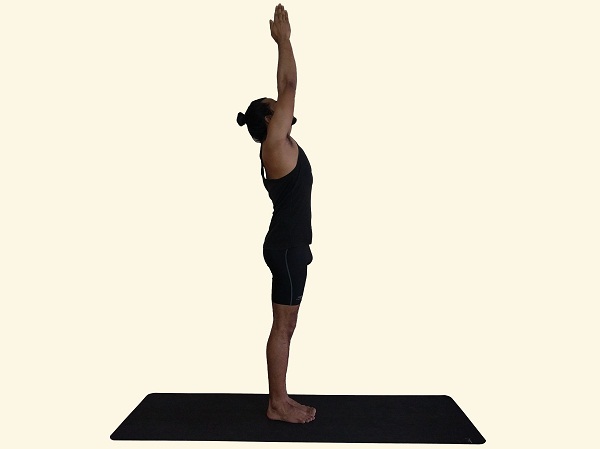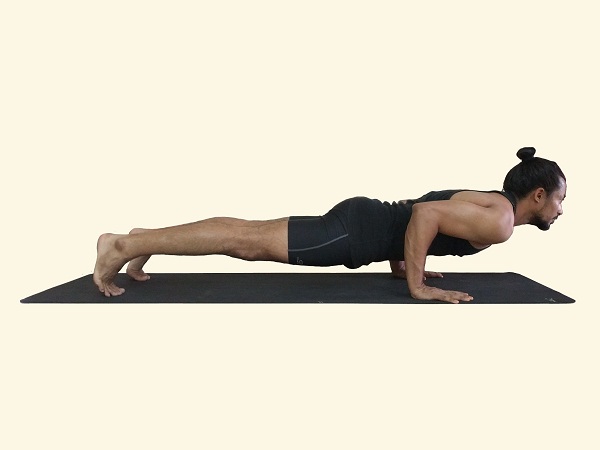Surya Namaskar – Sun Salutation
Surya – Sun, Namaskar – Salutation
Surya namaskar A is the starting warmup sequence of Ashtanga vinyasa yoga. It consists of seven different postures with ten transitions. These transitions are also called Vinyasa, which is a smooth transition between postures done with proper breaths.
Vinyasa
Vinyasa has become a very common word with lots of people teaching the vinyasa flow yoga, but because of its popularity, this word is not properly understood. So we will try to explain Vinyasa briefly.
Vinyasa is the movement done with a particular breathing action either inhale, exhale, or retention (puraka, rechaka, or kumbhaka).
Postures should be done with proper vinyasa. As a general rule when your chest is opening in a posture then you inhale and when you close up or your stomach is getting squashed then you exhale. Sometimes you also do kumbhaka (breath retention) which is done in the transition that requires lots of strength and core power.
Kumbhaka is done if you are doing the floatation instead of the jump back and forward (from urdhva uttanasana to chaturanga dandasana or vice versa).
If you are doing the wrong vinyasa then you might not get the same effect compared to the right one. As an experiment try to do the first transition with the wrong vinyasa. Eg. from the starting position (samasthiti) instead of inhaling, exhale and lift the hands up into Urdhva Hastasana. Observe how you feel. Does it feel right?
The tradition
Surya namaskar ancient yogic tradition of honoring the rising or setting of the sun (surya). It is thought that if the day and night were like inhale and exhale, dawn and dusk would be the pause between the inhalation and exhalation (kumbaka) and the perfect time for reflection, meditation, or yoga practice. This is the reason that traditionally the timing of the practice is chosen during sunrise and sunset.
How to use this sequence?
This sequence can be used in preparation for other postures heating up and stretching the body, bringing the connection between movement and breath. It can also be used as a complete exercise in itself. It tones and stretches the muscles, massages the inner organs, helps to relieve constipation, speeds up the metabolism, and helps to reduce weight.
Even spending 15 minutes of your day practicing the Sun Salutations can be used to calm the mind, and promote health and balance.

**The link to download the full-size pdf version of Surya namaskar B is at the bottom of the page.
Sun Salutation in Ashtanga Vinyasa
There are two Surya Namaskar sequences that the Ashtanga Vinyasa series is incomplete without. These two sequences Sun Salutation A and Sun Salutation B remain the same throughout all the different series. They allow you to truly connect your body and breath. Slowly you become familiar with the postures and you can flow through them without thinking, allowing your body to be moved by your breath, reaching a meditative flow.
Five repetitions each of the Surya namaskar A and B are done followed by the standing sequence and any of the series (primary, intermediate or advanced).
Steps with alignment, modifications, drishti, and vinyasa
START SAMASTHITI
Start, feet together, toes spread, weight evenly over the feet, thighs engaged (knee caps up), tail bone tucked under, abdomen in, shoulders rolled back, hands by the sides, chin parallel to the floor, and look at the tip of the nose. When you are doing your very first samasthiti you can stay in it for 5 breaths to ground and balance yourself. Second round onwards you just follow the vinyasa.
Modify: If you have lower back problems or find it difficult to stand with your feet together due to knees or thighs rubbing you may stand with the feet hip-width apart (still parallel)

1. Inhale – URDHVA HASTASANA
Bend the knees, raise the arms up over the head, bring the palms together and look to the thumbs.
Modify: Keep the hands shoulder-width apart if it is painful to keep them together

2. Exhale – UTANASANA
Straighten the legs, bend forwards from the hips, bringing your hands down, relax the neck look to your nose
Modify: If you have lower back problems keep the knees bent so that the palms come to the floor.

3. Inhale – URDVAH UTANASANA
Lengthen the spine, look forwards, and open the shoulders.
Modify: If you have slipped disc or lower back problems keep the knees bent so that the fingertips come to the floor. (Keep the spine straight)

4. Exhale – CHATURANGA DANDASANA
Jump or step the feet back, bend the elbows keeping them tucked into your sides, lowering the body. Knees stay off the floor.
Modify: If you are not strong enough for the full posture you have two options
- Plank
- In the same posture with the knees on the ground.

5. Inhale – URDVAH MUKHA SVANASANA
Point the toes away from the body, lift the chest, and knees stay off the ground. Opening the shoulders and looking up to the sky or the third eye.

6. Exhale – ADHO MUKHA SVANASANA
Tuck the toes under, lift the hips up, bring the shoulders down and look to the navel, stay here for 5 deep breaths.
Modify:
- First, come onto the knees, then lift up.
- Keep the knees a LITTLE bent to allow you to lengthen through the spine.

7. Inhale – URDVAH UTANASANA
Jump or step the feet together between the hands, lengthen the spine, look to the front, and open the shoulders. (Same as step 3)
8. Exhale – UTANASANA
Bring the crown of your head towards the floor, relax the neck look to your nose (Same as step 2)
9. Inhale – URDHVA HASTASANA
Bend the knees, raise the arms up over the head, bring the palms together and look to the thumbs. (Same as step 1)
10. Exhale – SAMASTHITI
Straighten the legs, and bring the arms to the sides. Repeat the sequence four more times.
Download full-size Sun salutation A, PDF version.
If you are looking to buy a high-quality Yoga mat the Manduka Pro is our absolute favorite. It’s the perfect texture and thickness. It works well in sweaty fast paces classes as well as for giving enough support when you want to stay in poses for a long time. The best part is the surface doesn’t degrade over time, we have been using ours daily for over 6 years and they are as good as new! The mat is easy to clean and has a lifetime warranty. Highly recommend this product.
Check out some more free resources on Ashtanga vinyasa yoga.